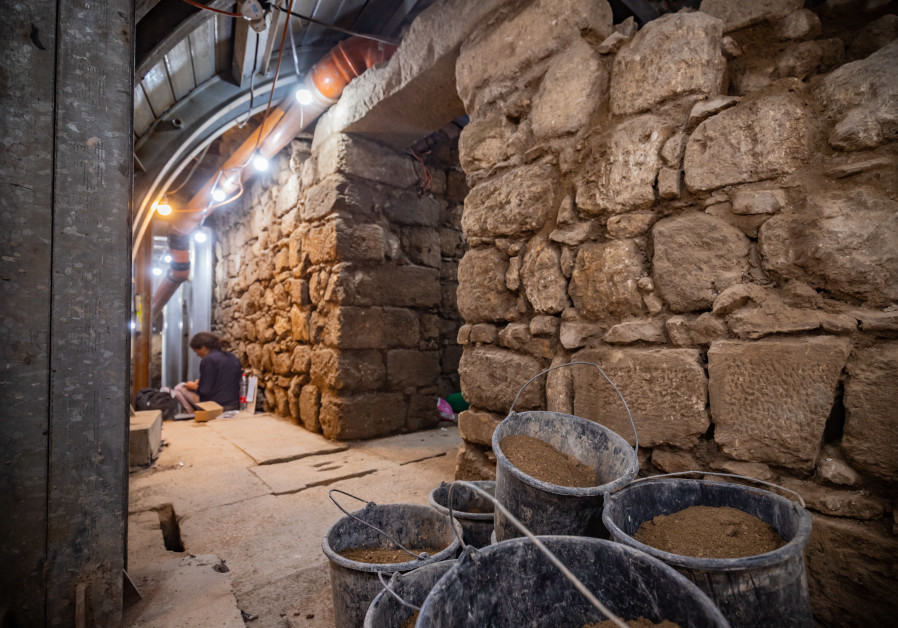A unique bronze ‘lucky charm’ lamp dating back to the end of the Second Temple period was unearthed in Jerusalem in a Roman structure built on the site known as Pilgrimage Road, the Israel Antiquities Authority announced on Wednesday.
The artifact, shaped as a half-face with grotesque features, represents a unique finding in the city and possibly in the whole land of Israel. It was uncovered during excavations carried out by the IAA in the Jerusalem Walls-City of David National Park.
Pilgrimage Road is the path which, according to experts, ancient Jews walked to ascent the Temple Mount as they were performing the commandment of going up to the holy sanctuary three times a year – in the festivals of Passover, Shavuot and Sukkot.
“The street was built during the period of Governor Pontius Pilates,” IAA archaeologist Ari Levy told The Jerusalem Post. “It was inaugurated around the year 30 CE and it was used for about 40 years until the Temple was destroyed in 70 CE.”
The 2,000-year-old road goes all the way from the Shiloah Pool – where pilgrims used to ritually purify themselves as required by Jewish law – to the area adjacent to the Western Wall known as Robinson’s Arch. Its imperial structure, as well as several items found during the excavation, such as stone vessels unable to receive ritual impurity, testify of its role in Jewish history.

The area was destroyed during the Great Jewish Revolt and lost its Jewish connotation. However, it remained strategic to ensure the access of the city to the pool.
“The Romans considered the location important and built a structure in order to protect the access of the city to the water,” Levy said.
During their work, the archaeologists encountered the building erected on top of the road and decided to excavate its foundations to find materials which would allow them to date it. This way, they also uncovered the lamp.
“This object is very symbolic,” the archaeologists explained. “It is a lamp, and it could have been used to make light, but there is much more to it than that. It was buried in the foundations of the building in order to bring luck to the structure and to the people who used it, in order to guard them.”
“Decorated bronze oil lamps were discovered throughout the Roman Empire,” Dr. Yuval Baruch of the IAA said in a press release. “For the most part, such oil lamps stood on stylish candelabras or were hung on a chain. Collections around the world contain thousands of these bronze lamps, many of which were made in intricate shapes, indicating the artistic freedom that Roman metal artists possessed.”
"Meanwhile, this half of a lamp, and in fact half a face, which was discovered in the City of David, is a very rare object, with only a few discovered in the whole world, and is the first of its kind to be discovered in Jerusalem," he said.
The reason why the lamp was shaped as only half a face, with bulging eyes and a menacing grin, remains a mystery. According to the archaeologists, it might have been connected to the need of attaching it to a flat object, such as a wall, or had spiritual and ritual reasons.
“The face depicted in the lamp is grotesque, and it appears to similar to a theater mask, which was a common theme in the Greco-Roman culture,” Levy said. “The separate head piece, which was connected in a different way is in the shape of an acanthus leaf, which inspired many artistic motifs in the ancient world, including the Corinthian capitols.”
The researchers were surprised to find out that the lamp still contains its wick. Future analysis will be able to determine whether the lamp was ever used.
Together with the lamp, the archaeologists found coins, pottery and organic material to perform a radio-carbon test, all of which confirmed that the building dated back to the period between the two Jewish Revolts.
After Jerusalem was turned into the Roman colony of Aelia Capitolina in 136 CE, the building and the area were definitely abandoned. Before coming to light again, almost two millennia later.